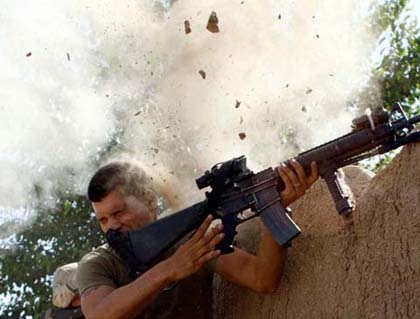Bad news about record civilian casualties in Afghanistan in 2011 once again hit headlines of national and international media. Deaths of innocent, voiceless and defenseless Afghans have, indeed, been the most dreadful aspect of expensive US-led Afghan war. As the war enters its second decade, more people are falling prey in the hands of terrorists. Unfortunately, NATO and Afghan government have badly failed to address this fundamental issue, let alone stopping the growing power of insurgents who threat peace and security of every individual in this country. UN, civil society and human rights organizations and media have voiced their concerns time and again over the growing civilian causalities but their voices have fallen on deaf ears as condition has worsened.
A UN report released on Saturday presents shocking rise of 8 percent in civilian casualties in Afghanistan. The report said the United Nations Assistance Mission in Afghanistan (UNAMA) documented 3,021 civilian deaths in the conflict in 2011 — up 8 percent from 2010, which saw 2,790 deaths and an increase of 25 percent from 2009, when 2,412 civilians were killed.The UN figure of civilian killing is, however, significantly higher than the Congressional Research Service report released recently according to which a total of 2,262 Afghan civilians died last year in the Afghan violence.
The growth in numbers of civilian killings in the last ten year, if on the one hand questions the roles of international community and Hamid Karzai's administration, on the other signals their shamefulness in handling the counter insurgency war. Hamid Karzai has publically admitted that its government and the Western countries backing it have failed to secure the life of Afghans. If security is not in place, all other social, political and economical gains are fragile and at the verge of collapse. Uncontrolled civilian killing is the main cause of rift and widening gap between Karzai administration and the public. Cities, towns, districts and villages are not safe and people travel with a high level of fear on the routes connecting the 34 provinces of Afghanistan.
About 150,000 international troops and more than 250,000 Afghan security forces are deployed across Afghanistan. They are only good in making 'big statements' in the media and blows the trumpet of their military operations against Taliban and other insurgents groups. According to them, Taliban are weaker and have been pushed back in their strongholds. But saying such things is only good on the paper because ground realities show the opposite.
A few weeks back, the NATO termed 2011 as a successful year in Afghanistan. In a "remarkably successful" year, Taliban had been forced onto the back foot in their southern stronghold, said International Security Assistance Force (ISAF) spokesman Brigadier General Carsten Jacobson. "The success has been so great that Taliban have largely lost control of the area and now rely on IEDs as their primary method of attack," he said. And in the east, troops "significantly disrupted the Haqqani network through operations Shamshir and Knife Edge, where coalition forces captured or eliminated over 500 leaders and fighters last fall". No doubt, in a war, enemies are killed and captured but it does not necessarily mean a great success against them. The ground realities speak oppositely.
The United Nations disagreed with NATO assessments, saying, in September, the number of security incidents was up 39 percent on the first eight months of 2010, while ISAF said they were down two percent.
The UNAMA report holds Taliban responsible for 77 percent of civilian deaths in 2011. It said "anti-government elements" — shorthand for the Taliban and other insurgent groups — were responsible for 2,332, or 77 percent, of conflict-related deaths in 2011, up 14 percent from 2010. This is clear indication of Taliban's growing operations and influence and failure of NATO and Afghan troops to counter their attacks.
Taliban leader, Mullah Muhammad Omar, should die out of shame. His army is disobeying him. In his Eid ul Fitre message last year he urged Taliban fighters to renounce killing of civilians as to him such acts were unacceptable and if deliberately undertaken, are against human rights. But Taliban, who recognize no human or women rights, killed the highest number of civilians in the same year. This signals that Omar has lost control over his army. He is only a symbolic leader and Taliban fighters seem to get their guidance from and are controlled by other parties.
The current UNAMA report presents a clear picture of coming years in Afghanistan. As we move ahead concerns increase further. There are serious doubts over the capability of Afghan security forces to stand against Taliban fighters in many provinces of Afghanistan in the absence of NATO troops.
France which has been a strong NATO member announced that it will withdraw its full forces from Afghanistan in 2013 – a year before its commitment under NATO - in reaction to killing of four French soldiers by an Afghan soldier last month. The US which is leading the war has decided to end its troops' combat role in 2014. These all increase worries over regaining of power by Taliban among Afghans. Their gaining of power would mean re-eruption of 90s' violence in Afghanistan when hundreds of thousands of people were massacred by Taliban.

